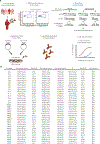Two recombinant human monoclonal antibodies that protect against lethal Andes hantavirus infection in vivo
- PMID: 30463919
- PMCID: PMC11073648
- DOI: 10.1126/scitranslmed.aat6420
Two recombinant human monoclonal antibodies that protect against lethal Andes hantavirus infection in vivo
Erratum in
-
Erratum for the Research Article: "Two recombinant human monoclonal antibodies that protect against lethal Andes hantavirus infection in vivo" by J. L. Garrido, J. Presscott, M. Calvo, F. Bravo, R. Alvarez, A. Salas, R. Riquelme, M. L. Rioseco, B. N. Williamson, E. Haddock, H. Feldmann, M. I. Barria.Sci Transl Med. 2019 Jan 16;11(475):eaaw4903. doi: 10.1126/scitranslmed.aaw4903. Sci Transl Med. 2019. PMID: 30651322 No abstract available.
Abstract
Andes hantavirus (ANDV) is an etiologic agent of hantavirus cardiopulmonary syndrome (HCPS), a severe disease characterized by fever, headache, and gastrointestinal symptoms that may progress to hypotension, pulmonary failure, and cardiac shock that results in a 25 to 40% case-fatality rate. Currently, there is no specific treatment or vaccine; however, several studies have shown that the generation of neutralizing antibody (Ab) responses strongly correlates with survival from HCPS in humans. In this study, we screened 27 ANDV convalescent HCPS patient sera for their capacity to bind and neutralize ANDV in vitro. One patient who showed high neutralizing titer was selected to isolate ANDV-glycoprotein (GP) Abs. ANDV-GP-specific memory B cells were single cell sorted, and recombinant immunoglobulin G antibodies were cloned and produced. Two monoclonal Abs (mAbs), JL16 and MIB22, potently recognized ANDV-GPs and neutralized ANDV. We examined the post-exposure efficacy of these two mAbs as a monotherapy or in combination therapy in a Syrian hamster model of ANDV-induced HCPS, and both mAbs protected 100% of animals from a lethal challenge dose. These data suggest that monotherapy with mAb JL16 or MIB22, or a cocktail of both, could be an effective post-exposure treatment for patients infected with ANDV-induced HCPS.
Copyright © 2018 The Authors, some rights reserved; exclusive licensee American Association for the Advancement of Science. No claim to original U.S. Government Works.
Conflict of interest statement
Figures




References
-
- Vaheri A, Strandin T, Hepojoki J, Sironen T, Henttonen H, Makela S, Mustonen J, Uncovering the mysteries of hantavirus infections. Nat. Rev. Microbiol. 11, 539–550 (2013). - PubMed
-
- Macneil A, Nichol ST, Spiropoulou CF, Hantavirus pulmonary syndrome. Virus Res. 162, 138–147 (2011). - PubMed
-
- Figueiredo LT, Souza WM, Ferres M, Enria DA, Hantaviruses and cardiopulmonary syndrome in South America. Virus Res. 187, 43–54 (2014). - PubMed
Publication types
MeSH terms
Substances
Grants and funding
LinkOut - more resources
Full Text Sources
Other Literature Sources
Medical

